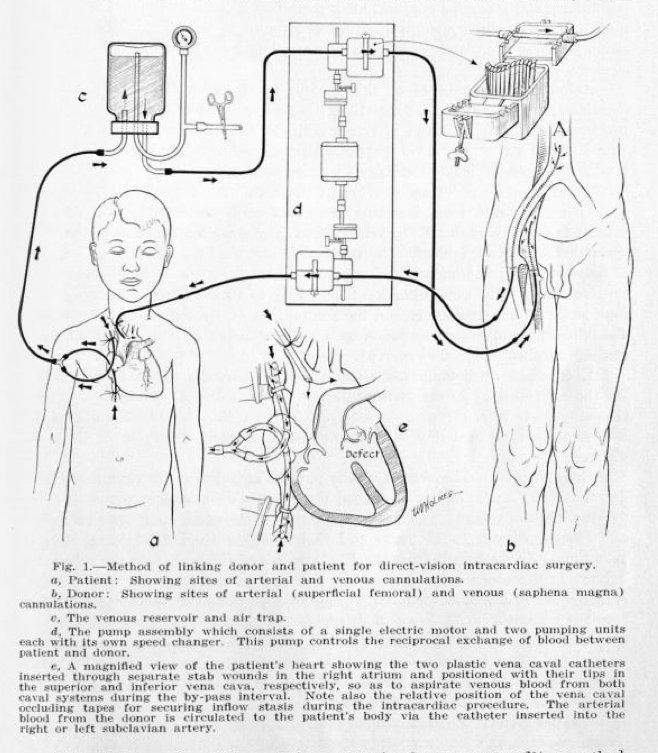March 26 marks the anniversary of one of the greatest milestones in heart surgery. On this day in 1954, at @UMNews, using cross-circulation on a patient for the very first time, Dr. C. Walton Lillehei performed the first successful repair of a ventricular septal defect. #CHD
3 years earlier, Dr. Clarence Dennis, one of Lillehei’s colleagues at @UMNews, made the first attempts to use a heart-lung bypass machine for heart surgery. Two patients were operated on within a month’s time, but both died in the OR, and his efforts stalled.
18 months earlier, Lillehei’s colleague, Dr. F. John Lewis, also at @UMNews, had performed the first successful surgery within the open human heart under direct visualization, closing a secundum ASD using inflow stasis and moderate total body hypothermia. https://twitter.com/thomasngmorris/status/903907370488782849
And 1 year earlier, Dr. John Gibbon at @TJUHospital was the first to successfully close an ASD in a patient using a heart-lung bypass machine. However, after his 2 subsequent operations failed, he became discouraged and never used his machine again.
In spite of these milestones, attempts to perform open heart surgery using extracorporeal circulation leading up to Dr. Lillehei’s historic surgery were largely met with failure. Hypothermia proved to be reliable for ASD repairs, but not for more complex defects.
Cross-circulation was initially intended only as an interim method to allow open heart experiments on dogs without the need for expensive equipment. However, Lillehei realized that dogs operated on in this manner survived at a much higher rate than those using a pump oxygenator.
Cross-circulation involves connecting the venous and arterial circulations of a donor (usually a parent with the same blood type) to the corresponding circulations of the child so that the donor serves as the oxygenator and a simple, mechanical pump substitutes for the heart.
Although most heart-lung bypass machines nowadays use a rotating peristaltic pump, Lillehei’s set-up used a Sigmamotor pump which provided more precise and reliable flow rates, important to ensure that the patient didn’t become volume overloaded or depleted during the case!
Although the idea of using cross-circulation was highly controversial for obvious reasons, the continued failures at other centers using mechanical heart-lung bypass gave Lillehei and his department chair, Dr. Owen Wangensteen, the courage to bring the technique to clinical use.
Gregory Glidden was born in February 1953. He had had an older sister who had died at 10 years old from a hole in her heart. At just a few weeks old started having recurrent pneumonia, and it soon turned out that Gregory too had a heart defect—a ventricular septal defect.
On March 26, 1954, 12-month-old Gregory Glidden and his father, Lyman, were brought to Operating Room B at the University of Minnesota. Using cross-circulation, Dr. Lillehei and his team successfully closed Gregory’s ventricular septal defect.
Gregory Glidden’s post-operative course was uneventful, but a week after his operation, he developed a rapidly progressing tracheobronchitis. Dr. Lillehei was at Gregory’s bedside when he died at 9:15 am on April 6. At autopsy, the VSD was noted to be well-closed.
Fortunately, in spite of Gregory’s death, Dr. Lillehei and his team pressed on. In the end, cross-circulation allowed them to repair several defects for the first time that had never been treatable before: VSD, AV canal, tetralogy of Fallot.
In total, 45 patients underwent heart surgery at @UMNews using cross-circulation between March 26, 1954, and July 19, 1955. Of these, 28 patients and every one of the donors survived, a success rate that far exceeded anything that had come before it.
With the dismal results that had been reported to date, cross-circulation was ultimately the real push that was needed to get open heart surgery moving. Here is Dr. Lillehei, himself, reflecting on the role of cross-circulation in bringing heart surgery into the modern era.

 Read on Twitter
Read on Twitter





















